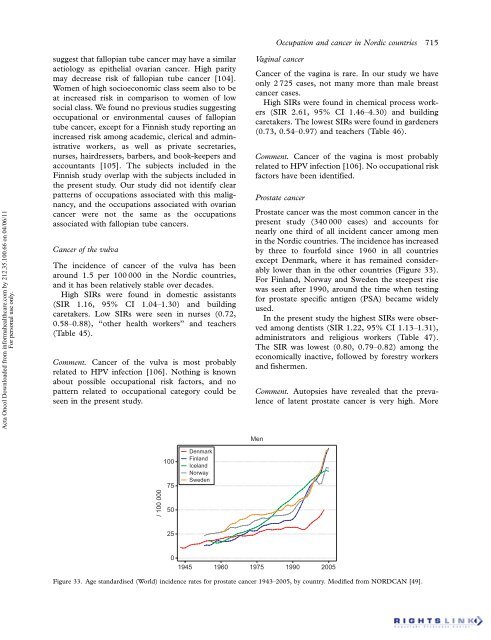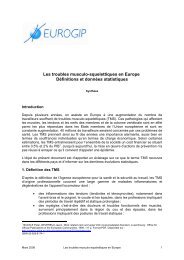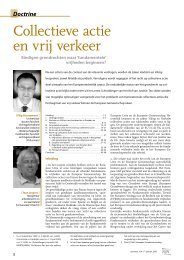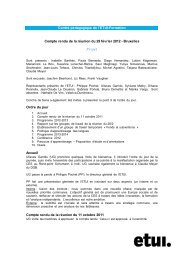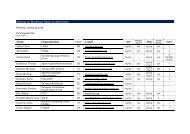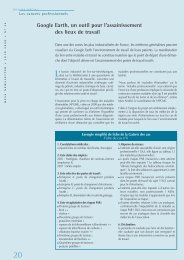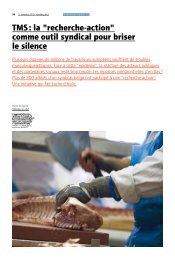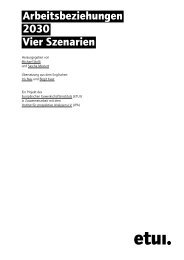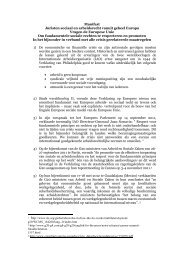Occupation and cancer - European Trade Union Institute (ETUI)
Occupation and cancer - European Trade Union Institute (ETUI)
Occupation and cancer - European Trade Union Institute (ETUI)
You also want an ePaper? Increase the reach of your titles
YUMPU automatically turns print PDFs into web optimized ePapers that Google loves.
Acta Oncol Downloaded from informahealthcare.com by 212.35.100.66 on 04/06/11<br />
For personal use only.<br />
suggest that fallopian tube <strong>cancer</strong> may have a similar<br />
aetiology as epithelial ovarian <strong>cancer</strong>. High parity<br />
may decrease risk of fallopian tube <strong>cancer</strong> [104].<br />
Women of high socioeconomic class seem also to be<br />
at increased risk in comparison to women of low<br />
social class. We found no previous studies suggesting<br />
occupational or environmental causes of fallopian<br />
tube <strong>cancer</strong>, except for a Finnish study reporting an<br />
increased risk among academic, clerical <strong>and</strong> administrative<br />
workers, as well as private secretaries,<br />
nurses, hairdressers, barbers, <strong>and</strong> book-keepers <strong>and</strong><br />
accountants [105]. The subjects included in the<br />
Finnish study overlap with the subjects included in<br />
the present study. Our study did not identify clear<br />
patterns of occupations associated with this malignancy,<br />
<strong>and</strong> the occupations associated with ovarian<br />
<strong>cancer</strong> were not the same as the occupations<br />
associated with fallopian tube <strong>cancer</strong>s.<br />
Cancer of the vulva<br />
The incidence of <strong>cancer</strong> of the vulva has been<br />
around 1.5 per 100 000 in the Nordic countries,<br />
<strong>and</strong> it has been relatively stable over decades.<br />
High SIRs were found in domestic assistants<br />
(SIR 1.16, 95% CI 1.04 1.30) <strong>and</strong> building<br />
caretakers. Low SIRs were seen in nurses (0.72,<br />
0.58 0.88), ‘‘other health workers’’ <strong>and</strong> teachers<br />
(Table 45).<br />
Comment. Cancer of the vulva is most probably<br />
related to HPV infection [106]. Nothing is known<br />
about possible occupational risk factors, <strong>and</strong> no<br />
pattern related to occupational category could be<br />
seen in the present study.<br />
/ 100 000<br />
100<br />
75<br />
50<br />
25<br />
Denmark<br />
Finl<strong>and</strong><br />
Icel<strong>and</strong><br />
Norway<br />
Sweden<br />
Vaginal <strong>cancer</strong><br />
Cancer of the vagina is rare. In our study we have<br />
only 2 725 cases, not many more than male breast<br />
<strong>cancer</strong> cases.<br />
High SIRs were found in chemical process workers<br />
(SIR 2.61, 95% CI 1.46 4.30) <strong>and</strong> building<br />
caretakers. The lowest SIRs were found in gardeners<br />
(0.73, 0.54 0.97) <strong>and</strong> teachers (Table 46).<br />
Comment. Cancer of the vagina is most probably<br />
related to HPV infection [106]. No occupational risk<br />
factors have been identified.<br />
Prostate <strong>cancer</strong><br />
Prostate <strong>cancer</strong> was the most common <strong>cancer</strong> in the<br />
present study (340 000 cases) <strong>and</strong> accounts for<br />
nearly one third of all incident <strong>cancer</strong> among men<br />
in the Nordic countries. The incidence has increased<br />
by three to fourfold since 1960 in all countries<br />
except Denmark, where it has remained considerably<br />
lower than in the other countries (Figure 33).<br />
For Finl<strong>and</strong>, Norway <strong>and</strong> Sweden the steepest rise<br />
was seen after 1990, around the time when testing<br />
for prostate specific antigen (PSA) became widely<br />
used.<br />
In the present study the highest SIRs were observed<br />
among dentists (SIR 1.22, 95% CI 1.13 1.31),<br />
administrators <strong>and</strong> religious workers (Table 47).<br />
The SIR was lowest (0.80, 0.79 0.82) among the<br />
economically inactive, followed by forestry workers<br />
<strong>and</strong> fishermen.<br />
0<br />
1945 1960 1975 1990 2005<br />
Comment. Autopsies have revealed that the prevalence<br />
of latent prostate <strong>cancer</strong> is very high. More<br />
Figure 33. Age st<strong>and</strong>ardised (World) incidence rates for prostate <strong>cancer</strong> 1943 2005, by country. Modified from NORDCAN [49].<br />
Men<br />
<strong>Occupation</strong> <strong>and</strong> <strong>cancer</strong> in Nordic countries 715


